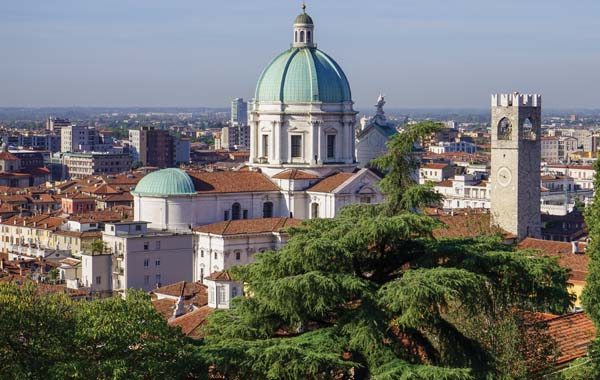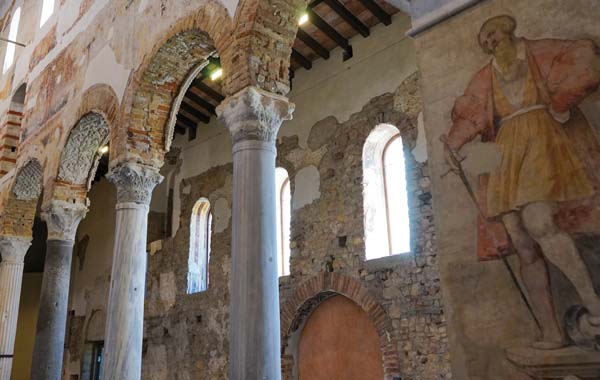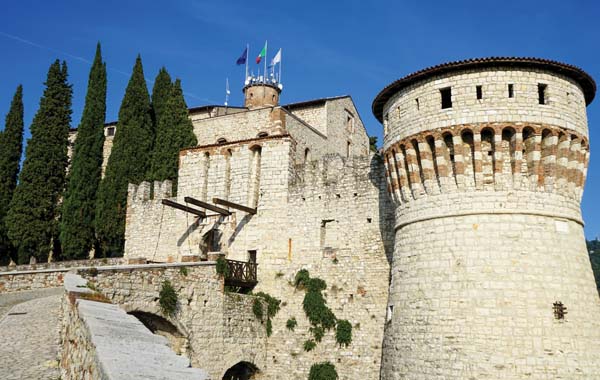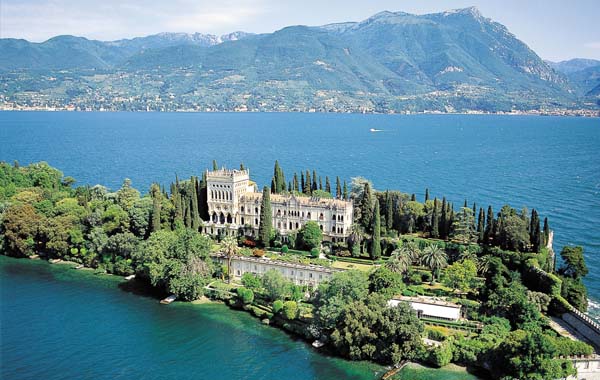Located between Milan and Lake Garda, Brescia is often overlooked by the more cursory travel journals. Valentina Nicastro gives us ten good reasons to visit the ‘Lioness of Italy’…

DISCOVER ITALIA!
Beautiful Brescia is one of those unsung Italian cities that promises an unforgettable experience to travellers who dare to take a diversion away from the standard tourist routes around northern Italy. Lombardy’s second-largest city is hardly ever mentioned in travel literature, yet La Leonessa d’Italia is a great destination with lots of history and culture to offer the more intrepid traveller – not to mention a fine local cuisine and the best sparkling wine in Italy. (And it’s not just here that they say that!)
Different rulers have all left their mark on the city over the centuries, and the result is a unique blend of architectural styles and historical features. Among the highlights are two cathedrals, four very different piazze and the largest archeological complex in northern Italy.

1 Three thousand years of history
The history of Brescia dates back to 1200 BC, and it was already an important city by the time it first came under Roman rule, in 225 BC. Its inhabitants became Roman citizens in 89 BC and remained so until the fall of the Empire, after which the city passed in and out of the hands of various rulers until it was brought into the new Kingdom of Italy in 1859.
The place to go for an introductory taste of Brescia’s long history is Via dei Musei, which has the fame of being the largest Roman archaeological area in northern Italy. Here you can see many remains of the city’s distant past, such as the Capitoline Temple commissioned by Emperor Vespasian, as well as the Roman amphitheatre and the old forum. The aptly named ‘Museum Street’ stretches for 800 metres from the Piazza della Loggia to the Monastero di Santa Giulia, which was founded by the Lombard king Desiderius and houses a number of artistic and architectural treasures from medieval times. You should also stop at the 17th-century Palazzo Martinengo.
2 A city with two cathedrals
Unusually, Piazza Paolo VI, Brescia’s central square, is the site of not one but two cathedrals. They stand right next to each other and the strong contrast between their entirely different beauties immediately catches the eye.
The Duomo Nuovo (New Cathedral) was begun in the early 1600s and constructed over the course of the following two centuries. It boasts a marvellous white marble façade and the third largest dome in Italy, after San Pietro in Rome and Santa Maria del Fiore in Florence. Smaller in size but just as fascinating, the Duomo Vecchio (Old Cathedral) dates back to the 11th century. Known as La Rotonda because of its unusual circular layout, it is one of just a few Romanesque churches of its kind in Italy and houses several important works of art, as well as what is purported to be a fragment of the Holy Cross.
3 A spectacular theatre
A Staircase hidden under the arcades of Corso Zanardelli leads to the entrance of the Teatro Grande, another of Brescia’s architectural marvels. The theatre sits on the ruins of the first public theatre, built in 1664, and has an interior that recalls La Scala in Milan (www.teatrogrande.it). The foyer is truly impressive, with golden stuccos, mirrors and trompe l’oeil frescoes that look like real galleries. It was used as a gambling room in the 19th century and is connected to an elegant café in which you can linger over a drink while soaking up the atmosphere.
It was in this theatre that Giacomo Puccini successfully staged Madama Butterfly in May 1904, after a disastrous debut at La Scala a few months earlier. The performance, attended by King Vittorio Emanuele III, is remembered with a special room displaying memorabilia from that day.

4 One of Italy’s largest fortresses
A Walk through Piazza Tito Speri and up the cobbled roads of Contrada Sant’Urbano leads to the Cidneo Hill, the site of the first settlement and also where the Visconti family built their castle many centuries later. Covering 75,000 square metres, the ‘Falcon of Italy’ is so called because of the commanding position it occupies above the city.
Behind its walls there is a lovely municipal park with lots of spots to relax in the shade of the trees, while the interiors are home to the Luigi Marzoli Arms Museum, displaying over 500 weapons, and a museum that retraces the history of the Italian Risorgimento, with a particular focus on the insurrection against the Austrians that earned Brescia the nickname Leonessa d’Italia.
5 A legendary vintage car race
Brescia is also the birthplace of the Mille Miglia (literally, the Thousand Miles), the famous car race that took place between 1927 and 1957 and consisted of a non-stop itinerary from Brescia to Rome and back, a distance of 1,600km. The city still celebrates this great event with an annual re-enactment using the cars that took part in the race, and there is also a special museum located outside the city centre.
Housed inside a former monastery complex dating from 1008 AD, the exhibition displays iconic cars by Bugatti, Alfa and Ferrari along with touchscreen stations that give access to itineraries, footage of the races and period photographs. There’s a gift shop selling everything from books to clothing, and you can also grab a bite to eat at the Taverna Mille Miglia, which used to be the traditional gathering places for the drivers.
6 Four beautiful squares
There are four historic squares in Brescia, each built in a different architectural style. The city’s main square is the medieval Piazza Paolo VI. This is where some of the most important historical and religious buildings are located, including the two cathedrals and the Broletto Palace, the oldest public building in Brescia. Neighbouring Piazza della Vittoria is characterised by the linear, geometric constructions of Fascist architecture. It was built in 1930s for big gatherings and houses the Torrione, Italy’s first skyscraper. Just a short walk away stands Piazza della Loggia, the elegant square built under the Venetians in pure Renaissance style; here is the Palazzo della Loggia, the seat of the town hall. The fourth is Piazza del Mercato, a pretty square surrounded by porticos and with a history as the centre of local trade activities.
7 Pirlo, the local aperitivo
When the clock strikes aperitivo o’clock, there’s only one drink to order in Brescia: Pirlo! The local tipple is made with white wine, Campari (or Aperol, depending on personal taste – although for many locals this is pure heresy) and soda. Its funny name comes from the local dialect – more precisely from the verb pirlare (literally, to fall), referring to the Campari falling gently into the white wine when they’re preparing the drink – pretty poetic, isn’t it? Just a bit of advice: don’t call it a spritz, because however similar to the popular drink from the Veneto region it may be, there’s one key difference: a pirlo is made with still wine, while a spritz takes sparkling prosecco. Two of the best places to enjoy an evening pirlo are Torre d’Ercole in Via Carlo Cattaneo and Casa Nani in Via Antiche Mura.
8 An award-winning cuisine
Nominated European region of gastromony in 2017, together with the other provinces of eastern Lombardy, Brescia offers a flavourful, hearty cuisine that reflects the varied territory in which it sits. Fresh, seasonal ingredients from the mountains, the plains and the lakes that surround the city take centre stage, accompanied by excellent local wines.
The Brescian speciality is casoncelli, a type of fresh pasta stuffed with meat or cheese and ricotta, and served with melted butter, sage and grated Parmesan. Various types of meat find their way onto local menus, from the spiedo (spit-roasted meat) served with polenta, to rabbit, and snails cooked with spinach and Parmesan. Another local gastronomic delight is the Bagòss, a richly-flavoured cheese produced in the nearby mountain village of Bagolino, while those with a sweet tooth should look for Brescian biscuits (best enjoyed dunked in milk or tea), bossolà (a soft, round cake), and persicata (little bars of peach jelly).
9 Excellent sparkling wines
Listing Franciacorta among its close neighbours is surely another good reason to visit Brescia. The wine district where the famous Italian bubbles are produced is only a 20-minute drive away, meaning you can easily combine a tour of the city with a visit to one of the more than 100 wineries around the area, ranging from internationally-recognised brands like Berlucchi and Ca’ del Bosco to smaller, family-run cellars.
A great way to explore the region is by following the Franciacorta Wine Route, a special 80km trail that stretches between the outskirts of Brescia and the shores of Lake Iseo, passing through vineyards, quaint villages and historic cellars along the way. Visiting the region during the Franciacorta Summer Festival (www.franciacorta.net) is another great way to fully experience the region’s cultural and enogastronomic offering.

10 Lake Garda on its doorstep
Just 30 Kilometres separate Brescia from Lake Garda, the largest lake in Italy and a popular holiday destination. Hugged by high mountains and verdant plains, this area is blessed with a particularly gentle climate that favours the growth of lush Mediterranean vegetation, filling the air with sweet citrus fragrances. All around are opulent villas, ancient castles and picturesque villages with cafés and restaurants to relax in and people-watch.
Among the lakeside jewels that can be easily reached from Brescia are Sirmione, a charming spa town nestled on a small peninsula jutting out into the lake, the buzzing resort town of Desenzano, with its pretty historical centre and some nice beaches, and the little harbour village of Limone.
